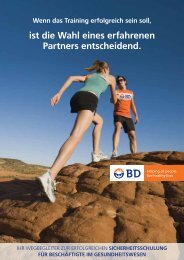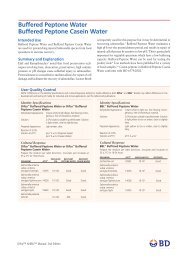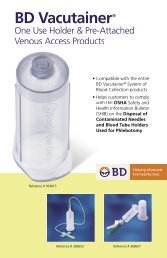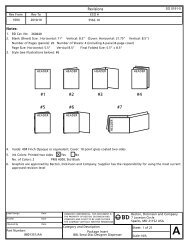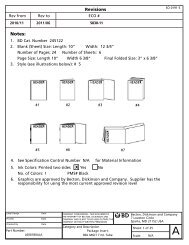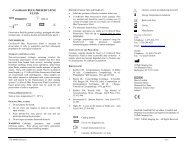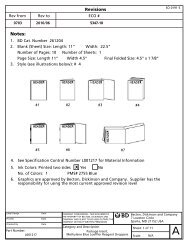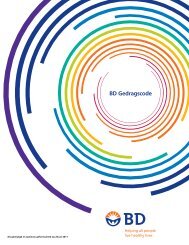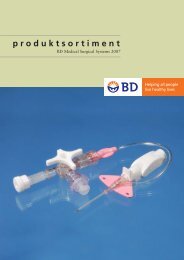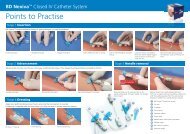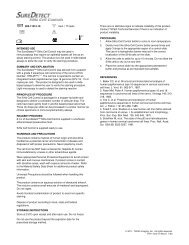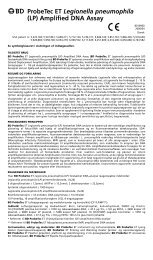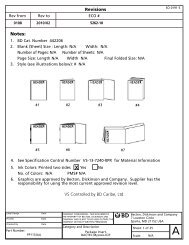Notes: - BD
Notes: - BD
Notes: - BD
You also want an ePaper? Increase the reach of your titles
YUMPU automatically turns print PDFs into web optimized ePapers that Google loves.
STORAGE AND HANDLING/SHELF LIFE<br />
Lids: Lids are individually packaged and must be stored unopened in a refrigerator at 2 – 8°C. DO NOT FREEZE. Visually<br />
inspect the package for holes or cracks in the foil package. Do not use if the packaging appears to be damaged. Lids in<br />
the original packaging, if stored as recommended, will retain expected reactivity until the date of expiration.<br />
Bases: Bases are packaged in two sets of ten, in BBLCrystal incubation trays. The bases are stacked facing down to<br />
minimize air contamination. Store in a dust free environment at 2 – 25°C, until ready to use. Store unused bases in<br />
the tray, in plastic bag. Empty trays should be used to incubate panels.<br />
Inoculum Fluid: BBLCrystal ANR, GP, RGP, N/H ID Inoculum Fluid (IF) is packaged in two sets of ten tubes. Visually<br />
inspect the tubes for cracks, leaks, etc. Do not use if there appears to be a leak, tube or cap damage or visual<br />
evidence of contamination (i.e., haziness, turbidity). Store tubes at 2 – 25°C. Expiration dating is shown on the tube<br />
label. Only BBLCrystal ANR, GP, RGP, N/H inoculum fluid should be used with BBLCrystal ANR panels.<br />
On receipt, store the BBLCrystal ANR kit at 2 – 8°C. Once opened, only the lids need to be stored at 2 – 8°C. The<br />
remaining components of the kit may be stored at 2 – 25°C. If the kit or any of the components are stored<br />
refrigerated, each should be brought to room temperature prior to use.<br />
SPECIMEN COLLECTION AND PROCESSING<br />
BBLCrystal ID Systems are not for use directly with clinical specimens. Use isolates from a nonselective blood agar<br />
medium such as CDC Anaerobe Blood Agar, Brucella Blood Agar, Columbia Blood Agar, or Schaedler Blood Agar. The<br />
test isolate must be a pure culture, no more than 24 – 48 h old for most genera; for some slow growing cocci (up to<br />
72 h) and Actinomyces species (72 – 96 h) older cultures may be acceptable. Only cotton-tipped applicator swabs<br />
should be used to prepare the inoculum suspension as some polyester swabs may cause problems with inoculation of<br />
the panels. (See “Limitations of The Procedure”.) Once lids are removed from the sealed pouches, they must be used<br />
within 1 h to ensure adequate performance. The plastic cover should remain on the lid until used.<br />
The incubator used should be humidified to prevent evaporation of fluid from the wells during incubation. The<br />
recommended humidity level is 40 – 60%. The usefulness of BBLCrystal ID Systems or any other diagnostic<br />
procedure performed on clinical specimens is directly influenced by the quality of the specimens themselves. It is<br />
strongly recommended that laboratories employ methods discussed in the Manual of Clinical Microbiology for<br />
specimen collection, transport and placement on primary isolation media.1 Other recommended readings relevant<br />
to anaerobic specimen handling include Wadsworth Anaerobic Bacteriology Manual9 and Principles and Practice<br />
of Clinical Anaerobic Bacteriology.3<br />
TEST PROCEDURE<br />
Materials Provided: BBLCrystal ANR ID Kit –<br />
20 BBLCrystal Anaerobe ID Panel Lids,<br />
20 BBLCrystal Bases,<br />
20 BBLCrystal ANR, GP, RGP, N/H ID Inoculum Fluid Tubes. Each tube has approximately 2.3 ± 0.15 mL of Inoculum<br />
Fluid containing: KCl 7.5 g, CaCl 2 0.5 g, Tricine N-[2-Hydroxy-1, 1-bis (hydroxymethyl)methyl] glycine 0.895 g,<br />
purified water to 1000 mL.<br />
2 incubation trays,<br />
1 BBLCrystal ANR ID Report Pad.<br />
Materials Not Provided: Sterile cotton swabs (do not use polyester swabs), incubator (35 – 37°C) non-CO 2 (40 – 60%<br />
humidity), McFarland No. 4 and No. 5 standards, BBLCrystal Panel Viewer, BBLCrystal ID System Electronic<br />
Codebook or BBLCrystal ANR Manual Codebook, BBL DMACA Indole Reagent Droppers, nonselective culture plate<br />
and catalase reagent.<br />
Also required are the necessary equipment and labware used for preparation, storage and handling of clinical<br />
specimens.<br />
Test Procedure: BBLCrystal ANR ID System requires Gram stain, catalase and indole test results. Prior to panel setup,<br />
catalase and indole tests should be performed. Perform indole test per instructions provided in the package<br />
insert. For catalase test a 15.0% solution of hydrogen peroxide with 1.0% Tween 80 added is recommended.9,24<br />
1. Remove lids from pouch. Discard desiccant. Once removed<br />
from the pouch, covered lids should be used within 1 h.<br />
Do not use the panel if there is no desiccant in the pouch.<br />
2. Take an inoculum fluid tube and label with patient’s specimen number. Using aseptic technique, with the tip of<br />
a sterile cotton swab (do not use a polyester swab) or a wooden applicator stick or disposable plastic loop, pick<br />
colonies of the same morphology from one of the recommended media (see section “Specimen Collection and<br />
Processing”).<br />
3. Suspend colonies in a tube of BBLCrystal ANR, GP, RGP, N/H ID Inoculum Fluid.<br />
5



